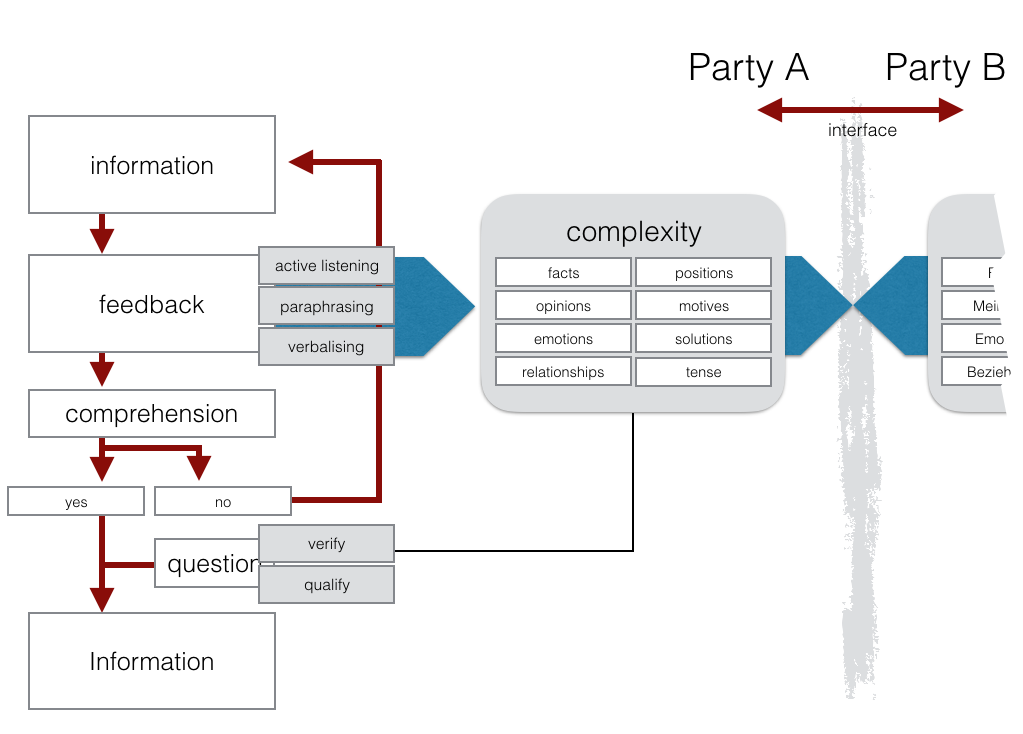The term active listening often is used very imprecisely. Integrated Mediation therefore designates the technique of precise listening. Precise listening is improving active listening by some additional techniques and functions.
You might call precise listening also as an active listening in four degrees. It helps unwinding the cognition process behind the mediation. It describes the approach of an active listening (looping) according to the principles and rules of Integrated Mediation. As it is embedded in the structure of mediation, it helps to more effectively deal with mediation.
This contribution will briefly describe how it works. It’s for members only.
The picture on top shows a scheme of a conversation under the concept of (integrated) mediation. The party talks (see the box „Information“). She introduces information this way. Each information is like a puzzle piece. The mediator helps merging them to a picture. In fact there are two pictures to be constructed. One refers the process, the other one refers the case (the problem to be solved). The mediator listens carefully to what the party is saying (see the box „Rückmeldung“). Active Listening means, he shows that he is listening carefully and that he is 100% present. He starts to feedback after the party has finished talking. Paraphrasing helps him to reflect the meaning of what the party has said. What he percepts, will be verbalized. It is very important to qualify the information by dimensions. Dimensions are comparable with meta-meanings of every information. Dimensioning is a method, which has been developed by Integrated Mediation especially. It’s a mean for virtualising mediation. The scheme above shows possible dimensions in the box named „Komplexität“, which means complexity. Dimensions therefore help dealing with complexity. The complexity box may be taken as a symbol for a dresser or a commode. It will be mentally created for each party and has several drawers. Each drawer represents a dimension of the information. Since dimensions have to correlate with the case on the one hand and with the process on the other hand, there are two different columns of drawers. The scheme above shows the drawers (dimensions) of the case (like facts, opinions, emotions, relationships, relationship levels and so on) in the left column and the dimensions of the process (like arguments, positions, issues, motives, solutions) in the right one. The drawers will be filled with information by the mediator’s feedback. Example: „You have mentioned facts like follows ……. The following arguments should reason your position. …. You think that ….“. The drawers will be filled in the mediator’s head. By time they will be used according to the phases of the mediation. As the drawers are similar built, information can be compared. Example: „The facts you mentioned are similar to those the other party mentioned. … Your opinions are not the same, as ….“ Attributing the dimensions steers the handling of information. Example: A solution will be postponed after phase four and qualified according to the motives. An argument will be related to positions which will become the balanced issue. Facts will be compared in phase four. If they are contested and relevant for solution, they will be evaluated. Opinions may differ. If parties fight for having the same opinion, it will be the point where a mediator steps into motives. It’s the mediator’s decision whether information is collected sufficiently in order to complete the puzzle pictures realising the mediation. The interrogation technique of precise listening is special. A principle of Integrated Mediation is to never ask without a leading paraphrase. The paraphrase should inspire the party and to let the talk go on without steerinmg the thoughts by questioning. The statements of the party are not accepted uncritically. The process of understanding involves understanding the steps of thinking. Small steps of thinking will be created. Maieutics is the most suitable technique for this. Example: „You said that, …. How did you come to this conclusion?“ or „You mean that …. What happens when a year has passed .. Is your opinion still correct? …“. The Maieutics should lead to a gain in knowledge. It is important for the mediator to confirm every thought step by step to make sure that the thought is not only in his head, but also in the head of the party. The rule of thumb is: The smaller the thinking, the greater the agreement. In this way, listening carefully enables not only a synchronisation of communication, but also of thought. With this scheme, the cognitive process can be realised. The thoughts are brought into an order that should enable the parties to find a solution themselves. More on Wiki-To-Yes or under listening.[/upme_private]


Hinterlassen Sie einen Kommentar
Sie müssen angemeldet sein um einen Kommentar zu schreiben.